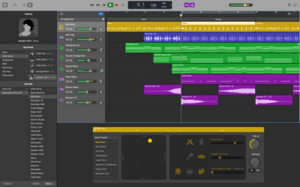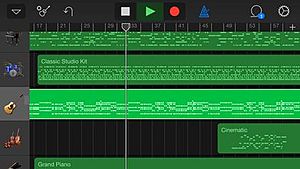GarageBand facts for kids
 |
|

GarageBand 10.4.1 on macOS Big Sur
|
|
| Developer(s) | Apple |
|---|---|
| Initial release | January 6, 2004 |
| Stable release |
10.4.5 / December 9, 2021
|
| Operating system | macOS |
| Type | Digital audio workstation |

GarageBand for iOS
|
|
| Developer(s) | Apple |
|---|---|
| Stable release |
2.3.12 / September 20, 2021
|
| Operating system | iOS, iPadOS |
| Type | Digital audio workstation |
| License | Proprietary |
GarageBand is music software made by Apple Inc. It allows you to make your own music and even make music with a MIDI keyboard. GarageBand includes hundreds of beats and audio loops.
The newest version, Version 10.0.2, has a new presentation of looks and with more music and sounds. Apple positions GarageBand for the consumer market. For the professional market, Apple offers another product, Logic Pro.
Features
Audio recording
GarageBand is a digital audio workstation (DAW) and music sequencer that can record and play back multiple tracks of audio. Built-in audio filters that use the AU (audio unit) standard allow the user to enhance the audio track with various effects, including reverb, echo, and distortion amongst others. GarageBand also offers the ability to record at both 16-bit and 24-bit Audio Resolution, but at a fixed sample rate of 44.1 kHz. An included tuning system helps with pitch correction and can effectively imitate the Auto-Tune effect when tuned to the maximum level. It also has a large array of preset effects to choose from, with an option to create your own effects.
Virtual software instruments
GarageBand includes a large selection of realistic, sampled instruments and software modeled synthesizers. These can be used to create original compositions or play music live through the use of a USB MIDI keyboard connected to the computer. An on-screen virtual keyboard is also available as well as using a standard QWERTY keyboard with the "musical typing" feature. The synthesizers were broken into two groups: [virtual] analog and digital. Each synthesizer has a wide variety of adjustable parameters, including richness, glide, cut off, standard attack, decay, sustain, and release; these allow for a wide array of sound creation. The five synth thumbnails are the ARP 2600, the Minimoog, the Waldorf Wave, the Nord Lead 1 and the Yamaha DX7.
Guitar features
In addition to the standard tracks, Garageband allows for guitar-specific tracks that can use a variety of simulated amplifiers, stompboxes, and effects processors. These imitate popular hardware from companies including Marshall Amplification, Orange Music Electronic Company, and Fender Musical Instruments Corporation. Up to five simulated effects can be layered on top of the virtual amplifiers, which feature adjustable parameters including tone, reverb, and volume. Guitars can be connected to Macs using the built-in input (requires hardware that can produce a standard stereo signal using a 3.5mm output) or a USB interface.
MIDI editing
GarageBand can import MIDI files and offers piano roll or notation-style editing and playback. By complying with the MIDI Standard, a user can edit many different aspects of a recorded note, including pitch, velocity, and duration. Pitch was settable to 1/128 of a semitone, on a scale of 0–127 (sometimes described on a scale of 1–128 for clarity). Velocity, which determines amplitude (volume), can be set and adjusted on a scale of 0–127. Note duration can be adjusted manually via the piano roll or in the score view. Note rhythms can be played via the software instruments, or created in the piano roll environment; rhythm correction is also included to lock notes to any time signature subdivision. GarageBand also offers global editing capabilities to MIDI information with Enhanced Timing, also known as Quantizing. While offering comprehensive control over MIDI files, GarageBand does not include several features of professional-level DAWs, such as a sequencer for drum tracks separate from the normal piano roll. However, many of these shortcomings have been addressed with each successive release of GarageBand.
Also of note, MIDI sequences edited or created in GarageBand cannot be exported to other DAWs or programs without first being converted to audio. A MIDI file can be extracted from a loop file created from a region, but this is not a general MIDI export facility, using manual steps and an open-source program.
Music lessons
A new feature included with GarageBand '09 and later is the ability to download pre-recorded music lessons from GarageBand's Lesson Store for guitar and piano. There are two types of lesson available in the Lesson Store: Basic Lessons, which are a free download, and Artist Lessons, which a user must purchase. The first Basic Lessons for both guitar and piano are included with GarageBand. In GarageBand 10, many sounds (aka patches, which Apple refers to as 'audio units') which are listed within the sound library are dimmed and unusable until the user pays an additional fee which allows the utilization of those sounds, bundled with the guitar and piano lessons. Attempting to click on and select the dimmed audio units to apply to the track causes promotional prompts to appear, requiring the user to log on with their Apple ID and furnish credit card information before knowing the price of the bundle.
In both types of the lesson, a music teacher presents the lesson, which is in a special format offering high-quality video and audio instructions. The lessons include a virtual guitar or piano, which demonstrates finger position and a musical notation area to show the correct musical notations. The music examples used in these lessons features popular music.
No new Artist Lessons were released in 2010, and Apple has not announced plans to release additional entries.
In June 2018, the GarageBand 10.3 update made Artist Lessons free.
Additional audio loops
Garageband includes an extensive array of pre-made audio loops to choose from with an option to import custom sound loops and an additional loop pack that is purchasable via the App Store. All loops have an edit and effects option.
Jam Packs
Jam Packs are Apple's official add-ons for GarageBand. Each Jam Pack contains loops and software instruments grouped into certain genres and styles.
Beginning with the release of the Remix Tools and Rhythm Section Jam Packs, each Jam Pack has been designated with a number. The release of GarageBand Jam Pack: World Music also saw a redesign in packaging.
MainStage 2
MainStage 2 by Apple also includes 40 built-in instruments – including synths, vintage keyboards, and a drum machine – to use in GarageBand. It also features an interface for live performances and includes a large collection of plug-ins and sounds.
Third-party instrument and Apple Loop packages
In addition to Apple, many other companies today offer commercial or shareware virtual software instruments designed especially for GarageBand, and collections of Apple Loops intended for GarageBand users.
Third-party vendors also offer extra loops for use in GarageBand. Users can also record custom loops through a microphone, via a software instrument, or by using an audio interface to connect physically a guitar or other hardware instruments to a Mac or iOS device.
Limitations
A lack of MIDI-out capability limits the use of external MIDI instruments. There is also only limited support for messages sent from knobs on MIDI keyboards, as only real-time pitch bend, modulation, sustain, and foot control is recognizable. However, since GarageBand '08, other parameters affected by MIDI knobs can be automated later, per-track. GarageBand has no functions for changing time signature mid-song though the software does now allow a tempo track to automate tempo changes.
Other than pitch bend, GarageBand is limited to the pitches and intervals of standard 12-tone equal temperament, so it does not natively support xenharmonic music. Logic Pro supports many different tunings. GarageBand does not support different tunings however, audio units which support micro tuning (using .scl or .tun files, or some other method) can be employed in GarageBand to produce alternative pitches.
Before GarageBand 10, there was no export option, and the only option was to save files as .band or export to iTunes. There is no built-in MIDI export feature, although regions can be manually exported as loops and converted to MIDI files.
GarageBand for iOS
On March 2, 2011, Apple announced a version of GarageBand for the iPad. It has many features similar to the macOS version. Music can be created using the on-screen instruments, which include keyboards, drums, a sampler, and various "smart instruments". It also acts as a multitrack recording studio with Stompbox effects and guitar amps. Songs can be emailed or sent to an iTunes Library. Additionally, projects can be imported to GarageBand for macOS, where they are further editable. This feature also allows instruments from the iOS platform to be savable to software instrument library on the Mac. However projects created in the macOS version cannot be opened in the iOS version. The app is compatible with iPhone 3GS or higher, the third generation iPod Touch or higher, and all versions of the iPad, including the iPad Mini. The app, with all instruments included, was available for $6.99 from the Apple App Store. In 2017, it was made free.
Differences from MacOS version
- No Music Lessons.
- Only three time signatures (4/4, 3/4, and 6/8).
- No master track.
- Automation is only available for volume.
- Live Loops layout.
- Audio Unit Extensions (via App Store).
- A Sound Library providing free, downloadable content such as additional keyboards, drum sets, and more.
- Limited exporting functions (As of 2.3.3, the option to export recorded project as songs to YouTube has been removed).
Availability
Prior to the launch of Apple's Mac App Store, GarageBand was only available as a part of iLife, a suite of applications (also including iPhoto, iMovie, iDVD, and iWeb) intended to simplify the creation and organization of digital content, or available on a new Mac. On January 6, 2011, GarageBand was made available independently on the Mac App Store in addition to iPhoto and iMovie. Since then Garageband's user base has increased drastically .
Supported music file formats
This app supports many music formats, including AIFF, WAV, and MIDI. The app can export songs to AAC, MP3, MP4 or AIFF format.
Support for 8-bit audio files was dropped in version 10.
See also
 In Spanish: GarageBand para niños
In Spanish: GarageBand para niños

